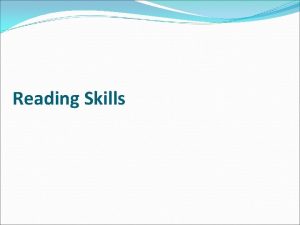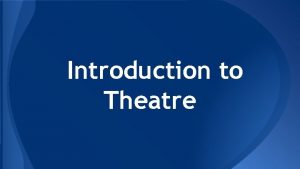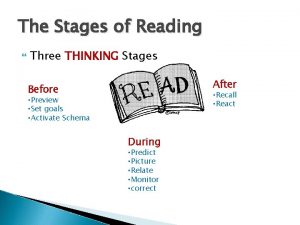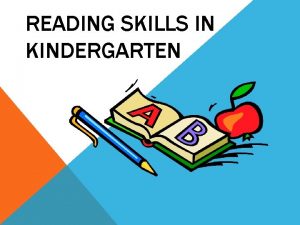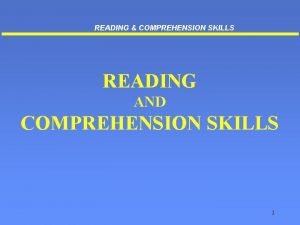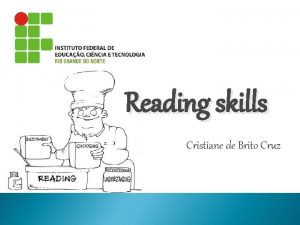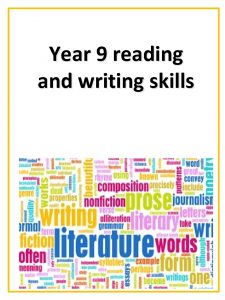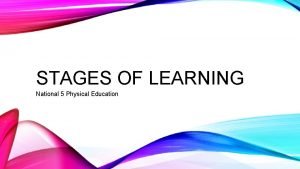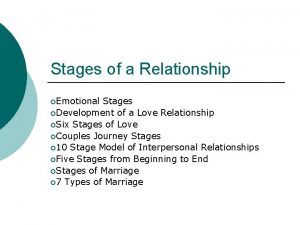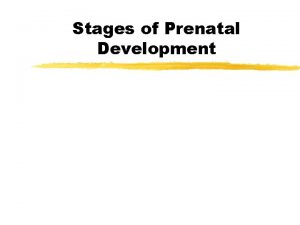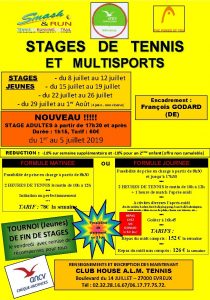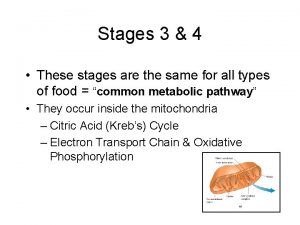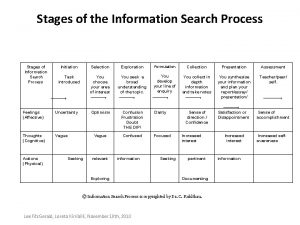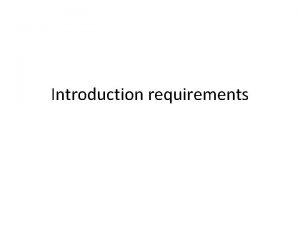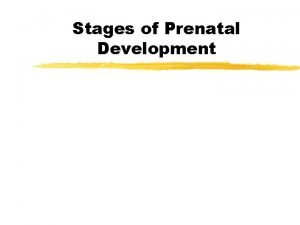Reading Skills TYPES OF READING THE STAGES OF


























- Slides: 26

Reading Skills TYPES OF READING THE STAGES OF READING STRATEGIES

Reading is the most important skill in English language from other language skills in acquiring language. If students are good at reading, they will be good at other language skills (writing, speaking, and listening).

Reasons why students may not understand the text - some students don‘t like to read, they only read the required textbook in order to be able to set for the achievement routine exams - students lack motivation to read, so even if they read, they have a negative attitude - for most learners, reading is an extremely difficult task that requires integrated skills – and it does not get easier with the passage of time and the accumulation of experience

TYPES OF READING • reading aloud • silent reading • Intensive • linguistic • content • Extensive • skimming • scanning

INTENSIVE READING Intensive reading calls attention to grammatical forms, discourse markers, and other surface structure details for the purpose of understanding literal meaning, implications, rhetorical relationships etc. (a zoom lens/magnifying glass strategy)

Intensive Reading Characteristics • Reader is intensely involved in looking inside the text • Focus on linguistic or semantic details of a reading • Focus on surface structure details such as grammar and discourse markers • Identify key vocabulary • Draw pictures to aid them (such as in problem solving) • Read carefully • Aim is to build more language knowledge rather than simply practice the skill of reading

Intensive Reading Activities • Identify main ideas and details • Making inferences • Looking at the order of information and how it effects the message • Identifying words that connect one idea to another • Identifying words that indicate change from one section to another

EXTENSIVE READING Extensive reading is carried out "to achieve a general understanding of a text. " • extensive reading as "occurring when students read large amounts of high interest material, usually out of class, concentrating on meaning, "reading for gist" and skipping unknown words. " • The aims of extensive reading are to build reader confidence and enjoyment

EXTENSIVE READING CHARACTERISTICS • The purposes of reading are usually related to pleasure, information and general understanding • Reading materials are well within the linguistic competence of the students in terms of vocabulary and grammar • Reading is individual and silent • Reading speed is usually faster than slower

SCANNING • A quick reading, focusing on locating specific information. • Scanning involves quick eye movements, not necessarily linear in fashion, in which the eyes wander until the reader finds the piece of information needed. • Scanning is used when a specific piece of information is required, such as a name, date, symbol, formula, or phrase, is required.

SCANNING CHARACTERISTICS • Scanning is used often with technical, scientific or professional materials to locate specific information. • Scanning is a valuable skill for second language learners to develop because often they do not require a detailed read of a text.

SCANNING ACTIVITIES - Make predictions and guesses - Use titles and tables of contents to get an idea of what a passage is about - activate prior knowledge - anticipate what they want to learn about the topic - Use titles, pictures, and prior knowledge to anticipate the contents of the text - Use key words, that may have been given to them by the teacher, that do not appear in the text, that allude to the main idea

SKIMMING Skimming is a quick reading to get: To know the general meaning of a passage To know how the passage is organized, that is, the structure of the text To get the author´s purpose

SKIMMING CHARACTERISTICS • Skimming is used to build student confidence and an understanding that it is possible to gain meaning without reading every word in a text. • Skimming is used as part of the SQ 3 R method of reading, often for speed reading. This method involves the student in surveying, questioning, reading, reviewing and reciting. • Skimming is used to review a topic.

STAGES OF READING

The stages of reading - pre-reading - reading itself - post-reading Each of these stages has its own characteristics, although they are related to one another. That is, the pre-reading stage leads to the while-reading stage and finally to the post-reading one. These stages make students understand comprehend text reading.

Pre-reading important for building confidence and giving a basic idea of the text helps with understanding the meaning without the need for looking up every word helps to make the next stages of reading more easily adaptable for the reader

Pre-reading activities Activate prior knowledge Set a purpose/focus Identify the author‘s purpose/audience Preview (formulate hypothesis about the context, use titles, illustrations, headings) Pose questions Make predictions Get an idea of texts' organization/ genre Vocabulary review Mind mapping Skim/ scan Brainstorm

WHAT GOOD READERS DO n n n BEFORE READING: Form hypotheses about the author’s purpose for writing. Make predictions based on illustrations, charts and subheadings. They consider what they already know about the topic or the genre. Set purposes for reading. Establish goals to help them pace their reading.

Reading itself The reading activities of while-reading stage help to encourage critical thinking and increase comprehension and easy retention.

Activities during reading • Read silently • Read aloud • Re-read • Check predictions • Clarify/verify comprehension • Analyze • Guess • Find answers • Word associations and grouping • Use context clues: semantic, syntactic, picture • Use phonetic cues: sound patterns, affixes, word roots, word chunk, word division • Dictionary use

WHAT GOOD READERS DO n n During reading: Sort relevant and irrelevant information, they organize data to find the gist , or main idea. Understand the text based on the print- sound relationships, meaning and language structure. Use decoding and context to construct meaning.

Post-reading stage Taking the time to check understanding and facilitate retention.

Post-reading activities • Reflect on what you have learned • Summarize/ paraphrase • Find relationships/mapping • Associate new information with old • Seek feedback • Interpret text • Make connections • Confirm predictions • Journals • Reading logs • Note-taking

WHAT GOOD READERS DO n n n After reading: Reflect on what and how they have read. Posing questions, evaluating strategies, confirming or adjusting predictions and hypotheses. Writing or discussing responses, and summarizing. They think about their thinking – analyse their own ideas.

My advice for all students is: • read as much as you can, read for pleasure (not just for school), and try to improve your skills in reading • you should not depend on your teachers all time – don‘t wait for your teacher to assign reading, and look for good and interesting books yourself
 2 types of reading
2 types of reading While reading activities
While reading activities Interpersonal skills and intrapersonal skills
Interpersonal skills and intrapersonal skills Soft skills definition
Soft skills definition Skills passport
Skills passport Hình ảnh bộ gõ cơ thể búng tay
Hình ảnh bộ gõ cơ thể búng tay Lp html
Lp html Bổ thể
Bổ thể Tỉ lệ cơ thể trẻ em
Tỉ lệ cơ thể trẻ em Voi kéo gỗ như thế nào
Voi kéo gỗ như thế nào Chụp tư thế worms-breton
Chụp tư thế worms-breton Alleluia hat len nguoi oi
Alleluia hat len nguoi oi Kể tên các môn thể thao
Kể tên các môn thể thao Thế nào là hệ số cao nhất
Thế nào là hệ số cao nhất Các châu lục và đại dương trên thế giới
Các châu lục và đại dương trên thế giới Công thức tính độ biến thiên đông lượng
Công thức tính độ biến thiên đông lượng Trời xanh đây là của chúng ta thể thơ
Trời xanh đây là của chúng ta thể thơ Mật thư tọa độ 5x5
Mật thư tọa độ 5x5 101012 bằng
101012 bằng độ dài liên kết
độ dài liên kết Các châu lục và đại dương trên thế giới
Các châu lục và đại dương trên thế giới Thể thơ truyền thống
Thể thơ truyền thống Quá trình desamine hóa có thể tạo ra
Quá trình desamine hóa có thể tạo ra Một số thể thơ truyền thống
Một số thể thơ truyền thống Cái miệng nó xinh thế chỉ nói điều hay thôi
Cái miệng nó xinh thế chỉ nói điều hay thôi Vẽ hình chiếu vuông góc của vật thể sau
Vẽ hình chiếu vuông góc của vật thể sau Nguyên nhân của sự mỏi cơ sinh 8
Nguyên nhân của sự mỏi cơ sinh 8




























